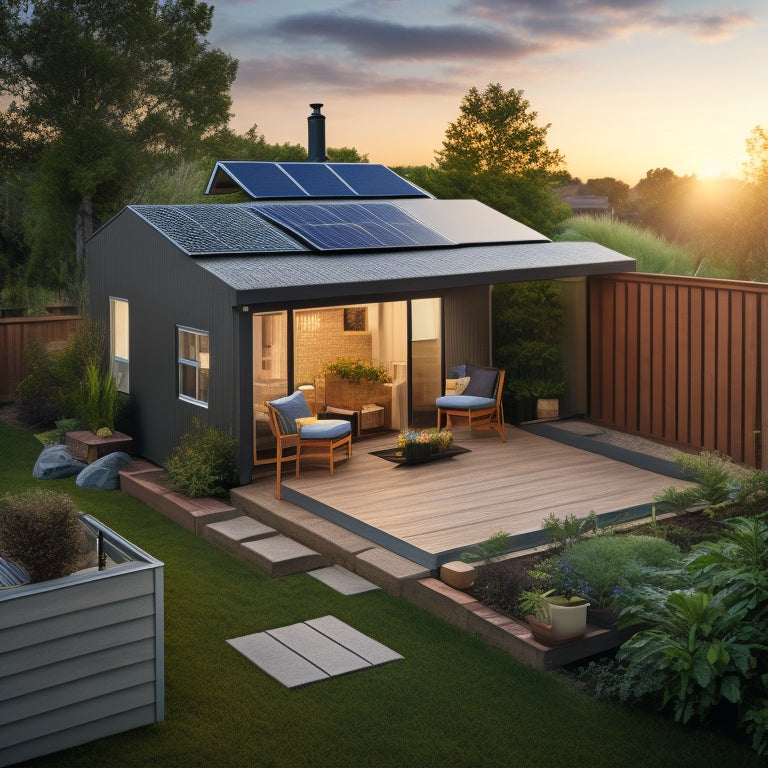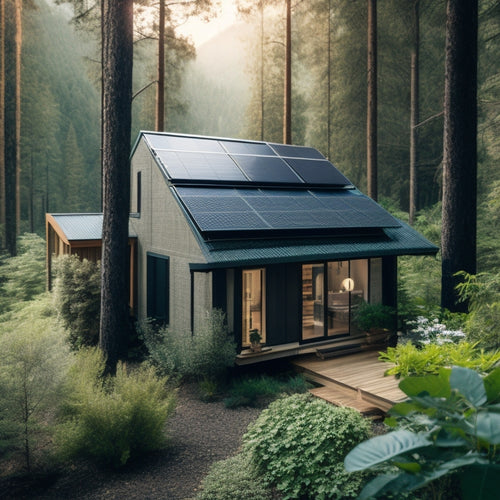
5 Best DIY Solar Energy Storage Solutions
Share
When it comes to DIY solar energy storage solutions, you'll want to take into account a few key options. A simple solar battery setup can provide approximately 1-2 kilowatt-hours of energy daily, while expanding your energy storage with a DIY deep cycle battery bank allows you to increase capacity. Solar power inverter solutions convert stored energy into usable power, and understanding energy usage patterns is essential for designing an effective energy storage system. Affordable off-grid energy options are also worth exploring, such as high-efficiency solar panels and effective energy storage systems. Now, explore deeper into each of these solutions to optimize your off-grid energy potential.
Overview
- A 200-400 watt solar panel array with a 12V deep cycle battery (200-400 ampere-hours) provides a typical DIY solar energy storage setup.
- Expanding energy storage by connecting multiple deep cycle batteries in parallel increases total ampere-hours to match energy demands.
- A high-efficiency solar power inverter (95% or higher) is crucial for converting stored energy into usable power for off-grid systems.
- Proper maintenance of the energy storage system, including ventilation and state of charge monitoring, ensures optimal performance and extends lifespan.
- A well-designed energy storage system, considering energy usage patterns and renewable energy source characteristics, maximizes renewable technology use and minimizes energy waste.
Simple Solar Battery Setup
How much energy can you realistically store with a simple solar battery setup? The answer depends on several factors, including the capacity of your solar panels, battery type, and charging efficiency.
A typical setup consists of a 200-400 watt solar panel array connected to a 12V deep cycle battery with a capacity of 200-400 ampere-hours.
When selecting a DIY solar kit, consider energy efficiency measures to lower overall consumption and reduce upfront costs. Additionally, verify the structural soundness of your roof to support the solar panels.
With proper battery maintenance, such as regular charging and monitoring, you can expect to store around 1-2 kilowatt-hours of energy per day.
Ascertain solar panel compatibility by selecting a battery that matches your panel's voltage and charging requirements.
DIY Deep Cycle Battery Bank
With a simple solar battery setup in place, you can further expand your energy storage capacity by building a DIY deep cycle battery bank. This involves connecting multiple deep cycle batteries in parallel to increase your overall battery capacity.
When designing your bank, consider the total ampere-hours (Ah) you need to meet your energy demands. For example, four 200Ah batteries will give you a total capacity of 800Ah.
It's crucial to select the best off-grid battery systems, considering factors such as depth of discharge and cycle life, to guarantee optimal performance. Additionally, look for solar panel battery combo deals that offer package discounts and enhanced performance.
To guarantee optimal performance, follow these maintenance tips: keep the batteries in a well-ventilated area, monitor their state of charge, and perform regular equalization charges to prevent sulfation.
Solar Power Inverter Solutions
You've successfully expanded your energy storage capacity with a DIY deep cycle battery bank, but now it's time to convert that stored energy into usable power for your off-grid system. A solar power inverter is the vital component that makes this possible.
When selecting an inverter, it's important to reflect on factors like inverter efficiency ratings and guarantee the inverter can handle the voltage and current output of your battery bank, considering the daily energy requirements and sizing of your system.
You'll need to choose from various solar inverter types, including string inverters, microinverters, and power optimizers. Each has its advantages and disadvantages, so it's important to reflect on factors like inverter efficiency, cost, and compatibility with your system.
Look for an inverter with high efficiency ratings (95% or higher) to minimize energy losses. Additionally, guarantee the inverter can handle the voltage and current output of your battery bank.
Energy Storage System Design
Designing an energy storage system requires a thorough understanding of your off-grid setup's specific needs and constraints. You need to take into account factors like your energy usage patterns, the size and type of your renewable energy source, and the local climate.
A well-designed energy storage system guarantees energy efficiency by minimizing energy waste and maximizing the use of renewable technology. You should calculate your energy requirements, choosing the right battery type and size, and configuring the system to optimize performance.
A balanced system will provide reliable power, reduce your reliance on the grid, and give you the freedom to live off-grid. By carefully designing your energy storage system, you'll be able to utilize the full potential of your renewable energy source.
Affordable Off-Grid Energy Options
Having refined your energy storage system, you're now ready to investigate affordable off-grid energy options that can further reduce your reliance on the grid.
A key consideration is solar panel selection, as high-efficiency panels can maximize energy harvesting while minimizing space requirements. Look for panels with high wattage ratings and low temperature coefficients to guarantee peak performance.
When paired with your energy storage system, these panels can provide a reliable source of power. By investing in these affordable off-grid energy options, you'll be taking a significant step towards energy independence.
With the right combination of solar panels and energy storage, you can break free from the grid and enjoy the freedom that comes with generating your own clean energy.
Frequently Asked Questions
Can I Use a DIY Solar Energy Storage System for My Rv?
You can definitely use a DIY solar energy storage system for your RV, integrating solar panels to charge your RV battery storage, giving you off-grid freedom and extending your escapade time, but make certain you follow safety guidelines and sizing calculations.
How Do I Dispose of Old Solar Batteries Safely?
When the rubber hits the road, you'll want to properly dispose of your old solar batteries to minimize environmental impact. You'll need to recycle them responsibly, as improper disposal can cause harm; look for local battery recycling programs to guarantee a guilt-free goodbye.
Are Lithium-Ion Batteries Safe for Home Energy Storage?
You're wondering if lithium-ion batteries are safe for home energy storage; they are, as they have built-in safety features, but you'll want to monitor their lithium safety and maintain a healthy battery lifespan through proper charging and maintenance.
Can I Mix Different Types of Solar Batteries in a Bank?
As you traverse the maze of solar battery types, remember that mixing them in a bank is like combining puzzle pieces - it's essential to guarantee battery compatibility, or you'll end up with a faulty system that drains your energy, and freedom.
Do I Need a License to Install My Own Solar Energy System?
You're responsible for ensuring your solar installation complies with local solar installation regulations, but you don't necessarily need a license; however, it's essential to research and understand your state's homeowner responsibilities and permitting requirements before starting the project.
Ready to Buy
You've investigated the top DIY solar energy storage solutions, from simple battery setups to extensive energy storage systems. As you commence your off-grid energy expedition, remember that the global energy storage market is projected to reach 1.2 terawatt-hours by 2025. With the right knowledge and tools, you can utilize the power of solar energy to reduce your carbon footprint and save on energy costs. By choosing the best DIY solution for your needs, you'll be well on your way to achieving energy independence.
Related Posts
-

How to Achieve a Zero-Waste Lifestyle for a Greener Tomorrow
To achieve a zero-waste lifestyle, start by adopting the principles of refusing, reducing, reusing, and recycling. Sw...
-

Solar Phone Chargers for Camping Essentials
Solar phone chargers are must-haves for your camping essentials, allowing you to stay connected while enjoying nature...
-

Off Grid Solar Batteries
As you shift to off-grid living, you'll rely on high-performance solar batteries to store excess energy generated by ...


